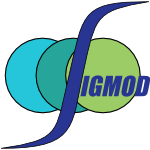71 papers:
 LCT-2015-KimOP #education #game studies #gesture #performance
LCT-2015-KimOP #education #game studies #gesture #performance- Developing an Educational Game for Art Education — Gesture Recognition-Based Performance Guidance for Mozart’s Opera Magic Flute (HSK, SHO, YHP), pp. 573–582.
 ECOOP-2015-SchwerhoffS #automation #lightweight #verification
ECOOP-2015-SchwerhoffS #automation #lightweight #verification- Lightweight Support for Magic Wands in an Automatic Verifier (MS, AJS), pp. 614–638.
 ITiCSE-2014-FerreiraM #algorithm #analysis #design #education #using
ITiCSE-2014-FerreiraM #algorithm #analysis #design #education #using- The magic of algorithm design and analysis: teaching algorithmic skills using magic card tricks (JFF, AM), pp. 75–80.
 CSCW-2014-MassimiHS #quote
CSCW-2014-MassimiHS #quote- “Real, but Glossy”: technology and the practical pursuit of magic in modern weddings (MM, RHRH, AS), pp. 854–865.
 POPL-2014-LeeP #logic #proving
POPL-2014-LeeP #logic #proving- A proof system for separation logic with magic wand (WL, SP), pp. 477–490.
 CHI-2013-FaresFK #question
CHI-2013-FaresFK #question- Can we beat the mouse with MAGIC? (RF, SF, OK), pp. 1387–1390.
 DUXU-CXC-2013-Rughinis #bibliography #collaboration #gamification
DUXU-CXC-2013-Rughinis #bibliography #collaboration #gamification- Work and Gameplay in the Transparent “Magic Circle” of Gamification — Insights from a Gameful Collaborative Review Exercise (RR), pp. 577–586.
 DUXU-NTE-2013-SamsonA #named
DUXU-NTE-2013-SamsonA #named- Tassophonics: Nanotechnology as the Magical Unknown (AS, KA), pp. 548–557.
 ICEIS-v1-2013-BimonteBPK #design #implementation #modelling #multi #uml
ICEIS-v1-2013-BimonteBPK #design #implementation #modelling #multi #uml- Design of Complex Spatio-multidimensional Models with the ICSOLAP UML Profile — An Implementation in MagicDraw (SB, KB, FP, MAK), pp. 310–315.
 SIGIR-2012-SaidJNPAS #case study #recommendation
SIGIR-2012-SaidJNPAS #case study #recommendation- Estimating the magic barrier of recommender systems: a user study (AS, BJJ, SN, TP, SA, CS), pp. 1061–1062.
 ICSE-2012-CaiC #concurrent #detection #named #scalability
ICSE-2012-CaiC #concurrent #detection #named #scalability- MagicFuzzer: Scalable deadlock detection for large-scale applications (YC, WKC), pp. 606–616.
 SIGMOD-2011-TekleL #datalog #performance #query #set
SIGMOD-2011-TekleL #datalog #performance #query #set- More efficient datalog queries: subsumptive tabling beats magic sets (KTT, YAL), pp. 661–672.
 DLT-J-2009-Jiraskova11
DLT-J-2009-Jiraskova11- Magic Numbers and Ternary Alphabet (GJ), pp. 331–344.
 CHI-2011-BiGMF #multi
CHI-2011-BiGMF #multi- Magic desk: bringing multi-touch surfaces into desktop work (XB, TG, JM, GWF), pp. 2511–2520.
 CHI-2011-RohsOS #interactive #lens #validation
CHI-2011-RohsOS #interactive #lens #validation- Interaction with magic lenses: real-world validation of a Fitts’ Law model (MR, AO, TS), pp. 2725–2728.
 CSCW-2011-BagalkotS #collaboration #named #towards
CSCW-2011-BagalkotS #collaboration #named #towards- MagicMirror: towards enhancing collaborative rehabilitation practices (NB, TS), pp. 593–596.
 ICLP-J-2011-GutmannTKBR #logic #probability #programming
ICLP-J-2011-GutmannTKBR #logic #probability #programming- The magic of logical inference in probabilistic programming (BG, IT, AK, MB, LDR), pp. 663–680.
 ICSM-2010-NagyVFGKK #assurance #developer #named #quality
ICSM-2010-NagyVFGKK #assurance #developer #named #quality- MAGISTER: Quality assurance of Magic applications for software developers and end users (CN, LV, RF, TG, FK, IK), pp. 1–6.
 CHI-2010-AshbrookS #design #gesture #named
CHI-2010-AshbrookS #design #gesture #named- MAGIC: a motion gesture design tool (DA, TS), pp. 2159–2168.
 CHI-2010-MarshallBP #collaboration #interactive
CHI-2010-MarshallBP #collaboration #interactive- Deception and magic in collaborative interaction (JM, SB, TPP), pp. 567–576.
 ICLP-2010-Alviano10 #datalog #set #source code
ICLP-2010-Alviano10 #datalog #set #source code- Dynamic Magic Sets for Disjunctive Datalog Programs (MA), pp. 226–235.
 DAC-2009-Thaker #question #verification
DAC-2009-Thaker #question #verification- Holistic verification: myth or magic bullet? (PAT), pp. 204–208.
 DLT-2009-Jiraskova
DLT-2009-Jiraskova- Magic Numbers and Ternary Alphabet (GJ), pp. 300–311.
 CHI-2009-ZhaoNII #interface
CHI-2009-ZhaoNII #interface- Magic cards: a paper tag interface for implicit robot control (SZ, KN, KI, TI), pp. 173–182.
 CIKM-2009-WangZZ #named
CIKM-2009-WangZZ #named- MagicCube: choosing the best snippet for each aspect of an entity (YW, LZ, YZ), pp. 1705–1708.
 SIGMOD-2008-SereniAM #compilation #datalog #optimisation
SIGMOD-2008-SereniAM #compilation #datalog #optimisation- Adding magic to an optimising datalog compiler (DS, PA, OdM), pp. 553–566.
 ITiCSE-2008-CurzonM
ITiCSE-2008-CurzonM- Engaging with computer science through magic shows (PC, PWM), pp. 179–183.
 CHI-2008-RohsO #lens
CHI-2008-RohsO #lens- Target acquisition with camera phones when used as magic lenses (MR, AO), pp. 1409–1418.
 SAS-2007-PayetS #analysis #bytecode #java
SAS-2007-PayetS #analysis #bytecode #java- Magic-Sets Transformation for the Analysis of Java Bytecode (ÉP, FS), pp. 452–467.
 HCI-IPT-2007-YoshidaMS #interactive #mobile #using #visual notation
HCI-IPT-2007-YoshidaMS #interactive #mobile #using #visual notation- Mobile Magic Hand: Camera Phone Based Interaction Using Visual Code and Optical Flow (YY, KM, TS), pp. 513–521.
 CIAA-2004-Zijl #difference #symmetry
CIAA-2004-Zijl #difference #symmetry- Magic Numbers for Symmetric Difference NFAs (LvZ), pp. 333–334.
 ICLP-2004-CumboFGL #datalog #source code
ICLP-2004-CumboFGL #datalog #source code- Enhancing the Magic-Set Method for Disjunctive Datalog Programs (CC, WF, GG, NL), pp. 371–385.
 PODS-2003-Behrend #database #deduction #evaluation #query #set
PODS-2003-Behrend #database #deduction #evaluation #query #set- Soft stratification for magic set based query evaluation in deductive databases (AB), pp. 102–110.
 SIGMOD-2003-ZuzartePMCLW #using
SIGMOD-2003-ZuzartePMCLW #using- WinMagic : Subquery Elimination Using Window Aggregation (CZ, HP, WM, QC, LL, KW), pp. 652–656.
 ITiCSE-2003-Kruse #approach #representation
ITiCSE-2003-Kruse #approach #representation- “Magic numbers” approach to introducing binary number representation in CSO (GK), p. 272.
 AdaEurope-2001-Amey #logic
AdaEurope-2001-Amey #logic- Logic versus Magic in Critical Systems (PA), pp. 49–67.
 KDD-2001-Elkan #challenge #data mining #lessons learnt #mining
KDD-2001-Elkan #challenge #data mining #lessons learnt #mining- Magical thinking in data mining: lessons from CoIL challenge 2000 (CE), pp. 426–431.
 CL-2000-Brass #named #query #web
CL-2000-Brass #named #query #web- SLDMagic — The Real Magic (With Applications to Web Queries) (SB), pp. 1063–1077.
 CHI-1999-ZhaiMI
CHI-1999-ZhaiMI- Manual and Gaze Input Cascaded (MAGIC) Pointing (SZ, CM, SI), pp. 246–253.
 CHI-1998-Fox #lens
CHI-1998-Fox #lens- Composing Magic Lenses (DF), pp. 519–525.
 CADE-1998-OhtaIH #on the #testing
CADE-1998-OhtaIH #on the #testing- On the Relationship Between Non-Horn Magic Sets and Relevancy Testing (YO, KI, RH), pp. 333–348.
 CADE-1997-HasegawaIOK #bottom-up #proving #set #theorem proving #top-down
CADE-1997-HasegawaIOK #bottom-up #proving #set #theorem proving #top-down- Non-Horn Magic Sets to Incorporate Top-down Inference into Bottom-up Theorem Proving (RH, KI, YO, MK), pp. 176–190.
 SIGMOD-1996-SeshadriHPLRSSS #algebra #cost analysis #implementation #optimisation
SIGMOD-1996-SeshadriHPLRSSS #algebra #cost analysis #implementation #optimisation- Cost-Based Optimization for Magic: Algebra and Implementation (PS, JMH, HP, TYCL, RR, DS, PJS, SS), pp. 435–446.
 PODS-1995-Wood #source code
PODS-1995-Wood #source code- Magic Factoring of Closure Programs (PTW), pp. 174–183.
 HPDC-1995-EwyEFM #case study #experience
HPDC-1995-EwyEFM #case study #experience- TCP/ATM Experiences in the MAGIC Testbed (BJE, JBE, VF, GJM), pp. 87–93.
 HPDC-1995-Richer #bibliography #challenge
HPDC-1995-Richer #bibliography #challenge- Invited Paper: Overview of the MAGIC Project — Challenges and Accomplishments (IR), p. 139.
 SIGMOD-1994-MumickP #database #implementation #relational
SIGMOD-1994-MumickP #database #implementation #relational- Implementation of Magic-sets in a Relational Database System (ISM, HP), pp. 103–114.
 PODS-1993-Morishita #fixpoint #source code
PODS-1993-Morishita #fixpoint #source code- An Alternating Fixpoint Tailored to Magic Programs (SM), pp. 123–134.
 INTERCHI-1993-Tognazzini #design #interface
INTERCHI-1993-Tognazzini #design #interface- Principles, techniques, and ethics of stage magic and their application to human interface design (BT), pp. 355–362.
 ICLP-1993-BolD
ICLP-1993-BolD- The Underlying Search for Magic Templates and Tabulation (RNB, LD), pp. 793–811.
 ILPS-1993-CodishD #logic programming #source code #using
ILPS-1993-CodishD #logic programming #source code #using- Analysing Logic Programs Using “Prop”-ositional Logic Programs and a Magic Wand (MC, BD), pp. 114–129.
 PODS-1992-GuptaM #recursion
PODS-1992-GuptaM #recursion- Magic-sets Transformation in Nonrecursive Systems (AG, ISM), pp. 354–367.
 PLILP-1991-Nilsson #abstract interpretation
PLILP-1991-Nilsson #abstract interpretation- Abstract Interpretation: A Kind of Magic (UN), pp. 299–309.
 ISLP-1991-KempSS #bottom-up #evaluation #modelling #set
ISLP-1991-KempSS #bottom-up #evaluation #modelling #set- Magic Sets and Bottom-Up Evaluation of Well-Founded Models (DBK, DS, PJS), pp. 337–351.
 PODS-1990-MumickFPR
PODS-1990-MumickFPR- Magic Conditions (ISM, SJF, HP, RR), pp. 314–330.
 PODS-1990-Ross #composition #datalog #set #source code
PODS-1990-Ross #composition #datalog #set #source code- Modular Stratification and Magic Sets for DATALOG Programs with Negation (KAR), pp. 161–171.
 SIGMOD-1990-MumickFPR
SIGMOD-1990-MumickFPR- Magic is Relevant (ISM, SJF, HP, RR), pp. 247–258.
 VLDB-1990-MumickPR
VLDB-1990-MumickPR- The Magic of Duplicates and Aggregates (ISM, HP, RR), pp. 264–277.
 NACLP-1990-Sagiv #question
NACLP-1990-Sagiv #question- Is There Anything Better than Magic? (YS), pp. 235–254.
 SEKE-1989-HanHZ #compilation #set
SEKE-1989-HanHZ #compilation #set- Derivation of Magic Sets by Compilation (JH, LJH, NZ), pp. 164–171.
 CCHSC-1988-Poetzsch-Heffter #compilation #implementation #optimisation #specification
CCHSC-1988-Poetzsch-Heffter #compilation #implementation #optimisation #specification- Optimizing Implementation of Aggregates in the Compiler Specification System MAGIC (APH), pp. 190–203.
 JICSCP-1988-Ramakrishnan88 #approach #logic programming #source code
JICSCP-1988-Ramakrishnan88 #approach #logic programming #source code- Magic Templates: A Spellbinding Approach to Logic Programs (RR), pp. 140–159.
 PODS-1987-BeeriR #on the #power of
PODS-1987-BeeriR #on the #power of- On the Power of Magic (CB, RR), pp. 269–284.
 SIGMOD-1987-SaccaZ
SIGMOD-1987-SaccaZ- Magic Counting Methods (DS, CZ), pp. 49–59.
 VLDB-1987-Gardarin #datalog #recursion #source code
VLDB-1987-Gardarin #datalog #recursion #source code- Magic Functions: A Technique to Optimize Extended Datalog Recursive Programs (GG), pp. 21–30.
 PODS-1986-BancilhonMSU #logic programming #set #source code
PODS-1986-BancilhonMSU #logic programming #set #source code- Magic Sets and Other Strange Ways to Implement Logic Programs (FB, DM, YS, JDU), pp. 1–15.
 DAC-1985-ScottO
DAC-1985-ScottO- Magic’s circuit extractor (WSS, JKO), pp. 286–292.
 DAC-1984-OusterhoutHMST #layout #named
DAC-1984-OusterhoutHMST #layout #named- Magic: A VLSI layout system (JKO, GTH, RNM, WSS, GST), pp. 152–159.
 DAC-1984-ScottO #interactive #named
DAC-1984-ScottO #interactive #named- Plowing: Interactive stretching and compaction in magic (WSS, JKO), pp. 166–172.
 DAC-1984-TaylorO #incremental
DAC-1984-TaylorO #incremental- Magic’s incremental design-rule checker (GST, JKO), pp. 160–165.
 DAC-1980-MacdonaldPP #composition #documentation
DAC-1980-MacdonaldPP #composition #documentation- Technical documentation by “MAGIC” (Machine Aided Graphics for Illustration and Composition (JBM, MKP, MJP), pp. 440–445.
 LCT-2015-KimOP #education #game studies #gesture #performance
LCT-2015-KimOP #education #game studies #gesture #performance ECOOP-2015-SchwerhoffS #automation #lightweight #verification
ECOOP-2015-SchwerhoffS #automation #lightweight #verification ITiCSE-2014-FerreiraM #algorithm #analysis #design #education #using
ITiCSE-2014-FerreiraM #algorithm #analysis #design #education #using CSCW-2014-MassimiHS #quote
CSCW-2014-MassimiHS #quote POPL-2014-LeeP #logic #proving
POPL-2014-LeeP #logic #proving CHI-2013-FaresFK #question
CHI-2013-FaresFK #question DUXU-CXC-2013-Rughinis #bibliography #collaboration #gamification
DUXU-CXC-2013-Rughinis #bibliography #collaboration #gamification DUXU-NTE-2013-SamsonA #named
DUXU-NTE-2013-SamsonA #named ICEIS-v1-2013-BimonteBPK #design #implementation #modelling #multi #uml
ICEIS-v1-2013-BimonteBPK #design #implementation #modelling #multi #uml SIGIR-2012-SaidJNPAS #case study #recommendation
SIGIR-2012-SaidJNPAS #case study #recommendation ICSE-2012-CaiC #concurrent #detection #named #scalability
ICSE-2012-CaiC #concurrent #detection #named #scalability SIGMOD-2011-TekleL #datalog #performance #query #set
SIGMOD-2011-TekleL #datalog #performance #query #set DLT-J-2009-Jiraskova11
DLT-J-2009-Jiraskova11 CHI-2011-BiGMF #multi
CHI-2011-BiGMF #multi CHI-2011-RohsOS #interactive #lens #validation
CHI-2011-RohsOS #interactive #lens #validation CSCW-2011-BagalkotS #collaboration #named #towards
CSCW-2011-BagalkotS #collaboration #named #towards ICLP-J-2011-GutmannTKBR #logic #probability #programming
ICLP-J-2011-GutmannTKBR #logic #probability #programming ICSM-2010-NagyVFGKK #assurance #developer #named #quality
ICSM-2010-NagyVFGKK #assurance #developer #named #quality CHI-2010-AshbrookS #design #gesture #named
CHI-2010-AshbrookS #design #gesture #named CHI-2010-MarshallBP #collaboration #interactive
CHI-2010-MarshallBP #collaboration #interactive ICLP-2010-Alviano10 #datalog #set #source code
ICLP-2010-Alviano10 #datalog #set #source code DAC-2009-Thaker #question #verification
DAC-2009-Thaker #question #verification DLT-2009-Jiraskova
DLT-2009-Jiraskova CHI-2009-ZhaoNII #interface
CHI-2009-ZhaoNII #interface CIKM-2009-WangZZ #named
CIKM-2009-WangZZ #named SIGMOD-2008-SereniAM #compilation #datalog #optimisation
SIGMOD-2008-SereniAM #compilation #datalog #optimisation ITiCSE-2008-CurzonM
ITiCSE-2008-CurzonM CHI-2008-RohsO #lens
CHI-2008-RohsO #lens SAS-2007-PayetS #analysis #bytecode #java
SAS-2007-PayetS #analysis #bytecode #java HCI-IPT-2007-YoshidaMS #interactive #mobile #using #visual notation
HCI-IPT-2007-YoshidaMS #interactive #mobile #using #visual notation CIAA-2004-Zijl #difference #symmetry
CIAA-2004-Zijl #difference #symmetry ICLP-2004-CumboFGL #datalog #source code
ICLP-2004-CumboFGL #datalog #source code PODS-2003-Behrend #database #deduction #evaluation #query #set
PODS-2003-Behrend #database #deduction #evaluation #query #set SIGMOD-2003-ZuzartePMCLW #using
SIGMOD-2003-ZuzartePMCLW #using ITiCSE-2003-Kruse #approach #representation
ITiCSE-2003-Kruse #approach #representation AdaEurope-2001-Amey #logic
AdaEurope-2001-Amey #logic KDD-2001-Elkan #challenge #data mining #lessons learnt #mining
KDD-2001-Elkan #challenge #data mining #lessons learnt #mining CL-2000-Brass #named #query #web
CL-2000-Brass #named #query #web CHI-1999-ZhaiMI
CHI-1999-ZhaiMI CHI-1998-Fox #lens
CHI-1998-Fox #lens CADE-1998-OhtaIH #on the #testing
CADE-1998-OhtaIH #on the #testing CADE-1997-HasegawaIOK #bottom-up #proving #set #theorem proving #top-down
CADE-1997-HasegawaIOK #bottom-up #proving #set #theorem proving #top-down SIGMOD-1996-SeshadriHPLRSSS #algebra #cost analysis #implementation #optimisation
SIGMOD-1996-SeshadriHPLRSSS #algebra #cost analysis #implementation #optimisation PODS-1995-Wood #source code
PODS-1995-Wood #source code HPDC-1995-EwyEFM #case study #experience
HPDC-1995-EwyEFM #case study #experience HPDC-1995-Richer #bibliography #challenge
HPDC-1995-Richer #bibliography #challenge SIGMOD-1994-MumickP #database #implementation #relational
SIGMOD-1994-MumickP #database #implementation #relational PODS-1993-Morishita #fixpoint #source code
PODS-1993-Morishita #fixpoint #source code INTERCHI-1993-Tognazzini #design #interface
INTERCHI-1993-Tognazzini #design #interface ICLP-1993-BolD
ICLP-1993-BolD ILPS-1993-CodishD #logic programming #source code #using
ILPS-1993-CodishD #logic programming #source code #using PODS-1992-GuptaM #recursion
PODS-1992-GuptaM #recursion PLILP-1991-Nilsson #abstract interpretation
PLILP-1991-Nilsson #abstract interpretation ISLP-1991-KempSS #bottom-up #evaluation #modelling #set
ISLP-1991-KempSS #bottom-up #evaluation #modelling #set PODS-1990-MumickFPR
PODS-1990-MumickFPR PODS-1990-Ross #composition #datalog #set #source code
PODS-1990-Ross #composition #datalog #set #source code SIGMOD-1990-MumickFPR
SIGMOD-1990-MumickFPR VLDB-1990-MumickPR
VLDB-1990-MumickPR NACLP-1990-Sagiv #question
NACLP-1990-Sagiv #question SEKE-1989-HanHZ #compilation #set
SEKE-1989-HanHZ #compilation #set CCHSC-1988-Poetzsch-Heffter #compilation #implementation #optimisation #specification
CCHSC-1988-Poetzsch-Heffter #compilation #implementation #optimisation #specification JICSCP-1988-Ramakrishnan88 #approach #logic programming #source code
JICSCP-1988-Ramakrishnan88 #approach #logic programming #source code PODS-1987-BeeriR #on the #power of
PODS-1987-BeeriR #on the #power of SIGMOD-1987-SaccaZ
SIGMOD-1987-SaccaZ VLDB-1987-Gardarin #datalog #recursion #source code
VLDB-1987-Gardarin #datalog #recursion #source code PODS-1986-BancilhonMSU #logic programming #set #source code
PODS-1986-BancilhonMSU #logic programming #set #source code DAC-1985-ScottO
DAC-1985-ScottO DAC-1984-OusterhoutHMST #layout #named
DAC-1984-OusterhoutHMST #layout #named DAC-1984-ScottO #interactive #named
DAC-1984-ScottO #interactive #named DAC-1984-TaylorO #incremental
DAC-1984-TaylorO #incremental DAC-1980-MacdonaldPP #composition #documentation
DAC-1980-MacdonaldPP #composition #documentation









